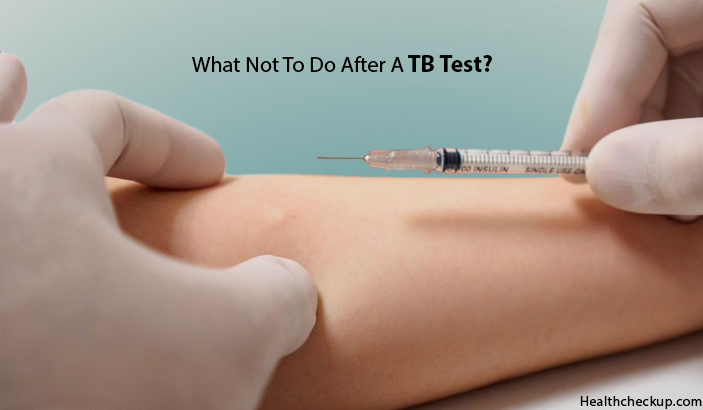Tuberculosis (TB) is a disease caused by an organism called Mycobacterium Tuberculosis. It is a disease that mainly affects the lungs but it can affect any organ of the human body except nails and hair. Its impact on world health remains significant and sadly it accounts for nearly 1.5 million deaths per year. The Mantoux tuberculin skin test is one of the standard methods of determining whether an immune competent person is exposed to Mycobacterium Tuberculosis.
The principle behind this investigation is called a Delayed Hypersensitivity Reaction, which is an immune reaction. In practice, the health care provider injects a solution called “Tuberculin” intradermal to the anterior aspect of the left forearm and that will trier an immune reaction. Patients who are undergoing this procedure should know about what not to do after performing a tuberculin test.
[Read – Side Effects of Latent TB Treatment]
What Not To Do After a TB Test
The test is performed preferably during the day time, either as an outpatient or an inward patient. Patients should be informed that the tuberculin agent contains no live organism, so there is no chance of developing the disease as a post-procedure complication. If the patient is an outpatient, it is important to educate about what not to do after the test. There are only a minimum number of side effects they can experience.
- Sometimes the injection site might become itchy but scratching around the injection site should be avoided because it can cause redness around and affect the reading of the test. It can lead to false positivity in interpretation. If it’s itchy persistently, some clinicians recommend putting a cold face cloth on the site and pat the site dry. Otherwise applying lotions or local remedies is not advised. Do not cover the site with any bandage or plaster and always leave the site open, because it might interfere with the true reading of the test. There is no harm in gentle washing of the arm with water and drying it with a piece of clean cloth.
- The patient is advised to come back to the clinician after 48-72 hours to recheck on the injection site to interpret the results. This should be reviewed by an experienced clinician to prevent false interpretations. In addition, the patient should be asked to seek medical advice immediately if there is any difficulty in breathing or generalized body itching suggestive of anaphylaxis. Because there have been reported cases of anaphylaxis as an allergy reaction to the injected agent.
- Having a bath after the test is not considered as not to do an action because it has no effect on the immune reaction caused by the tuberculin agent. There are no given specific restrictions in using the arm which the test has been done in activities of daily living. The patient can engage in their usual day to day work after the test and bed rest is not required.
- Since the tuberculin reaction is an immune reaction, the patient is advised to avoid consumption of food and beverages that the patient has known allergy after the procedure, because they can cause confusion with the test result. Also, the patient is advised to inform the doctor whenever he/she is given a new drug such as antihistamines, steroids, antibiotics which may alter the immune status of the patient.
- The Mantoux test result reading can be done by measuring the distribution of the induration reaction over the skin, obviously noticing the colour change. Readings are taken at day 2 to day 4 and the positive reading is considered as 10-14 millimetres induration on the skin in an immune competent patient. In an immune suppressed patient >5 millimetres induration is considered as positive. Attention should be paid on not to measure the redness but the induration only. The test has a poor positive predictive value for current active disease.
[Read – What Are Positive and Negative TB Skin Tests]
There are many factors that affect the results of the Mantoux Test. The test can have false positives as well as false negatives. False negatives are seen in immunosuppressed patients and in the wrong technique of reading the result. False positives can be due to previous tuberculosis infection, BCG vaccination or wrong technique of interpreting the results.
The redness appearing after one week of the test could be a delayed reaction indicating a positive test but there is a lack of firm evidence. When administrating the tuberculin solution, it should be injected intradermally. In addition to the quality of the equipment and outdated tuberculin solution, incorrect administration technique of the tuberculin solution can lead to a redness appearing after one week.
Before performing the test, the patient should be explained about the procedure, the reason for doing it and the information regarding the illness which can be gained at the end. After performing the test it is always the clinician’s responsibility to educate the patient regarding the things which should be and should not be done after a tuberculin test.
Dr. Chauturi is an experienced writer specializing in English language and Medical Sciences, and degree holder in Medicine, Bachelor of Surgery at University of Sri Jayewardenepura currently awaiting her internship.









